Alignment for LLM visibility is incredibly complex, but doable

I’ve straddled both the brand marketing and SEO industries for the past decade now. That dynamic has made it particularly interesting to watch how the concept of brand alignment has seeped into the search marketing vernacular.
To quote my favorite baseball player, Yogi Berra, “You can observe a lot just by watching.”
I’ve watched and I’ve observed how the conversation about brand alignment for LLM visibility has gone from “nice to have” to an absolute necessity. LLMs can expose a weak brand alignment while rewarding a strong brand alignment with increased visibility.
With that, I want to kick things off by better explaining exactly what brand alignment looks like and how you can achieve it.
What happens if you don’t have brand alignment?
I once had a call with a potential enterprise-level client whose company had recently run a Super Bowl ad. I knew five seconds into the call that I probably didn’t want to work with this client.
My take on their situation was that they were in what I call a “maturity inflection point.” This is when a brand has an amazing product or service and they release it in the right way, in the right place, and at the right time. Don’t underestimate how powerful a good product can be when its stars all align.
What inevitably happens in such cases is that too much of the success of the company is attributed to marketing (and the marketing was never really that great to begin with). In reality, the success was simply due to the momentum of the initial magical moment where the product was released into perfect conditions.
Built for how people search today. Track your brand across Google rankings and AI search in one place.

Brands in this situation hit a wall almost without exception. They need to take the next evolutionary step into who they are, who they focus on, and how they communicate because their marketing tactics haven’t caught up with where the market and audience are (hence why I call it a “maturity inflection point”).
When this happens, brands have two choices:
- They can pivot and evolve (i.e., mature)
- They can pay more money to perform
When you lose traction because your marketing’s efficacy was riding on the momentum of the product, you have to either evolve or pay more to play more.
(I know we’re not talking about LLM visibility yet, but I promise you we have been this whole time.)
The potential client I was speaking with was stuck in this very problem, and they were not happy when I recommended option one—pivot and evolve. They also didn’t like option two—spending more money (but that had already happened well before our Zoom call).
The major hangup was an inability to understand how brand alignment impacts performance. “What do you mean our brand strategy is making it harder to perform and costing more money? What does one have to do with the other?!”
The answer to the question is alignment. They have to do with each other because of alignment.
The issue of alignment is not new. It is new for performance marketers (SEOs, etc.), but it is not a new concept. It’s a very old and very important concept that the search marketing industry just wasn’t yet 100% aware of.
Now we are aware (and I’ll explain why), but from what I observe, we don’t yet know what “alignment” actually is.
In the case I’ve been discussing, it meant aligning the emotional targeting embedded within the Super Bowl ad (which was very good, by the way) with the brand’s homepage. Otherwise, people would (and did) Google the brand (as they, like me, had never heard of them) after watching the ad. Of course, having a good SEO team in place, the brand ranked #1 for its brand name.
The issue was, when you got to the site, none of the messaging or USPs from the $5M Super Bowl ad were present on the website. An obvious problem. The user won’t see any emotive alignment and will bounce. This is actually something companies in this situation should take into account. Quite often, you’ll see a brand run search ads (PPC ads) for its own brand name to capture users who hit a specific campaign (such as a Super Bowl ad) and send them to a landing page tailored to and aligned with the campaign.
In other words, as opposed to aligning the Super Bowl ad and threading a needle between the emotional pain point it hit on and the homepage, companies instead often spend countless millions of dollars producing and running a campaign such as a Super Bowl ad and then hand Google countless thousands of dollars to run search ads because the actual homepage doesn’t align.
Poor alignment produces poorer performance at higher costs. It’s not a new problem.
However, when a technology spreads its wings across the entire web and attempts to synthesize this information into an output of two to three paragraphs… brand alignment takes on renewed importance.
Actually, I am going to take a mulligan on that. Not renewed importance—renewed focus.
Why?
Why brand alignment is so important to LLM visibility
Brand alignment has always been important for performance. The value of alignment was never in question. Rather, it was the extent to which marketers valued that reality that was “debatable”—until LLMs came along.
Alignment across the brand has and does impact performance across the board. We may not have spoken about it in these specific terms, that’s true. SEOs, for example, have spoken about the concept of “brand alignment” in the context of E-E-A-T (Experience, Expertise, Authoritativeness, and Trustworthiness).
To that end, a good number of SEOs have recommended that sites “stay in their topical lane” so that Google can better see the site as an authority in that topical space (conversely, a disconnected topical focus can water down the site’s identity and authority). I personally spoke about this topic way back at SMX West in 2020.
What I described above is the very concept of brand alignment, simply discussed in the context of Google’s algorithm. Conceptually, they are one and the same.
To summarize this singular concept:
If you don’t build a strong brand identity and express that identity in a consistent way, Google’s algorithm will not identify you as an authority in your vertical.
When the above doesn’t happen, marketing becomes more expensive. If we don’t have enough topical focus (and therefore authority) across the site, Google won’t rank it well (all things being equal).
If we can’t organically “capture” these keywords, we’re left to either pursue other channels or pay to play on the Google SERP (i.e., run search ads). Thus, poor performance isn’t only a lack of captured opportunities, but also the catalyst for increased performance costs.
Along come LLMs
The problem with the concept I described above is that it’s very abstract. It’s hard to pinpoint the consequences and the costs of misalignment for performance and marketing budgets (although, definitely not an impossible task).
What LLMs did was make this once very ethereal construct incredibly concrete.
Companies can now see how LLMs do or don’t properly understand their brands. Brands can see where one LLM understands the brand one way, while another LLM sees things differently. Brands can even literally see old reputations lingering in AI outputs.
What’s more, with citations, you can often see who the culprit is.
How so?
Most medium- to large-sized companies don’t have one team exclusively creating content. At the enterprise level, the split is usually for SEO to handle the blog content and for the brand team to handle things like landing pages and the like.
It is quite common for those two teams to not sync extensively. Therefore, it is entirely possible for one content team to highlight one aspect of the company’s offering while another team highlights a different aspect.
This is very easy to see from an SEO perspective. The SEO team (who, again, is often running blog content) may see search volume opportunities and create content that speaks to certain elements of the offering because of those metrics. The brand team, having different considerations, may focus on a different aspect of that very same product or service.
Which take on the company’s offering do LLMs then adopt?
The lack of brand alignment becomes quite visible in an LLM world.
As I mentioned, you can often see the culprit in the citations themselves. If the LLM in question (e.g., ChatGPT, AI Mode, etc.) is adopting the wrong brand positioning and the citation leads to a landing page from your own site, then it’s obvious that the team responsible for that page is unaligned.
Thus far, we have misalignment between the brand and SEO teams, but the possibilities are really endless. If, for example, the LLM is citing a press release that takes the wrong positioning, then the PR team may need to be consulted. If the citations are from third-party sources, then perhaps the outreach team or owned media team needs to be brought into alignment. And so forth and so on.
LLMs make misalignment immediately apparent.
This isn’t a hypothetical scenario. What I described above is something I’ve seen firsthand with my own clientele and from conversations I’ve had around the industry.
Let me walk you through a fictitious example.
For argument’s sake, say Black and Decker wanted to pivot beyond personal lawn care and into industrial-level products (which I get no sense of; I am simply using this as an example).
In such a scenario, an LLM output such as the one below would not be ideal:
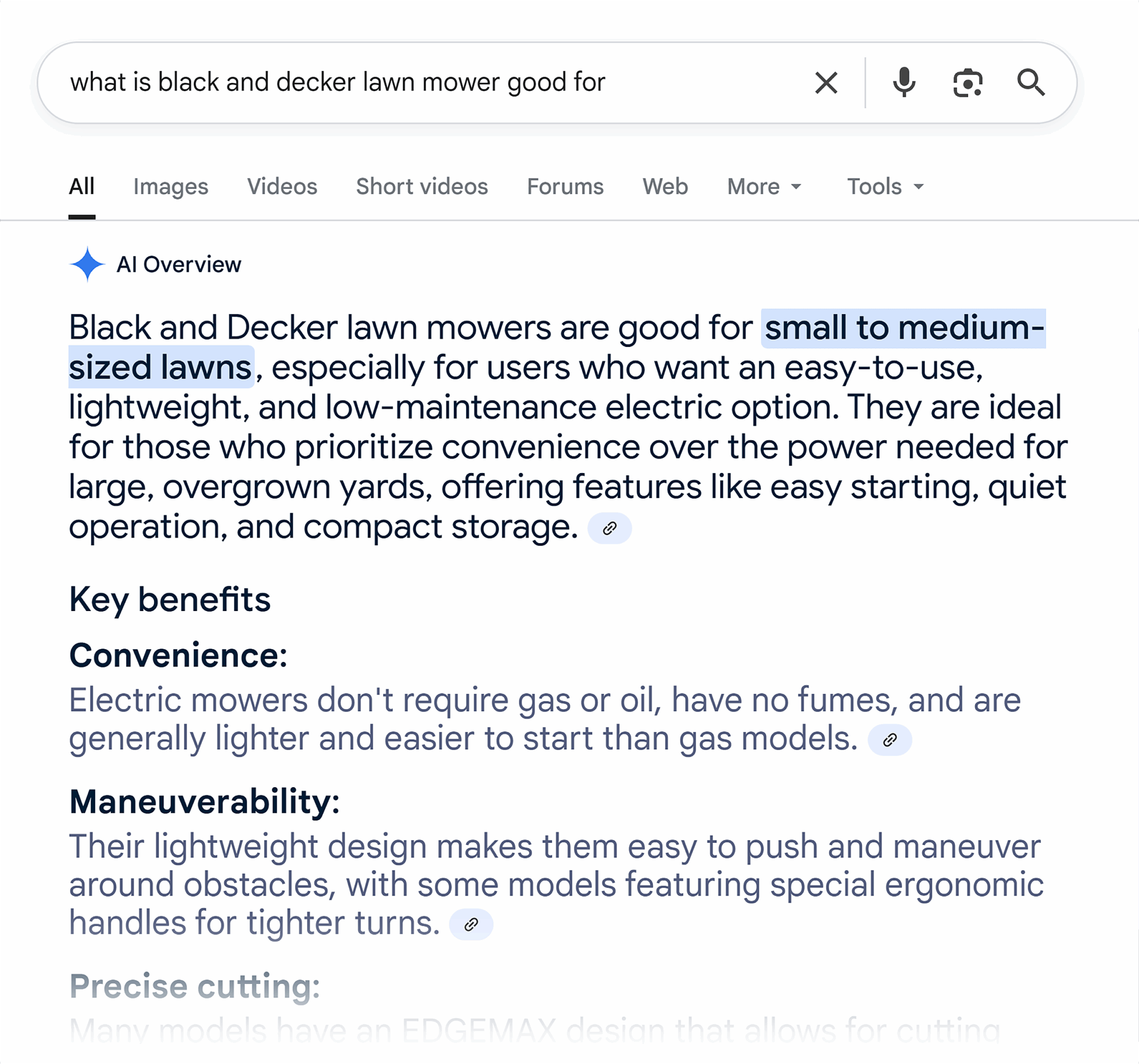
If the brand was looking to expand its offering and become known as a product suitable for industrial lawn care, seeing “… and suitability for smaller yards” appear inside an LLM output would be a red flag.
Moreover, from the first citation, we might see that the brand’s own content could be contributing to this perception.
Just a quick look at the category page on the Black and Decker website would confirm this:

The image used by the brand isn’t of someone cutting the hedges at a business complex or a university. It’s someone in their own yard (remember that this is a fictitious example, and this is actually exactly what the brand wants).
You could see the same positioning across any of the brand’s social media. It all readily comes through. The content focuses on personal lawn care, not industrial-level products (which, as a final clarifying reminder, is the brand’s actual positioning and targeting).
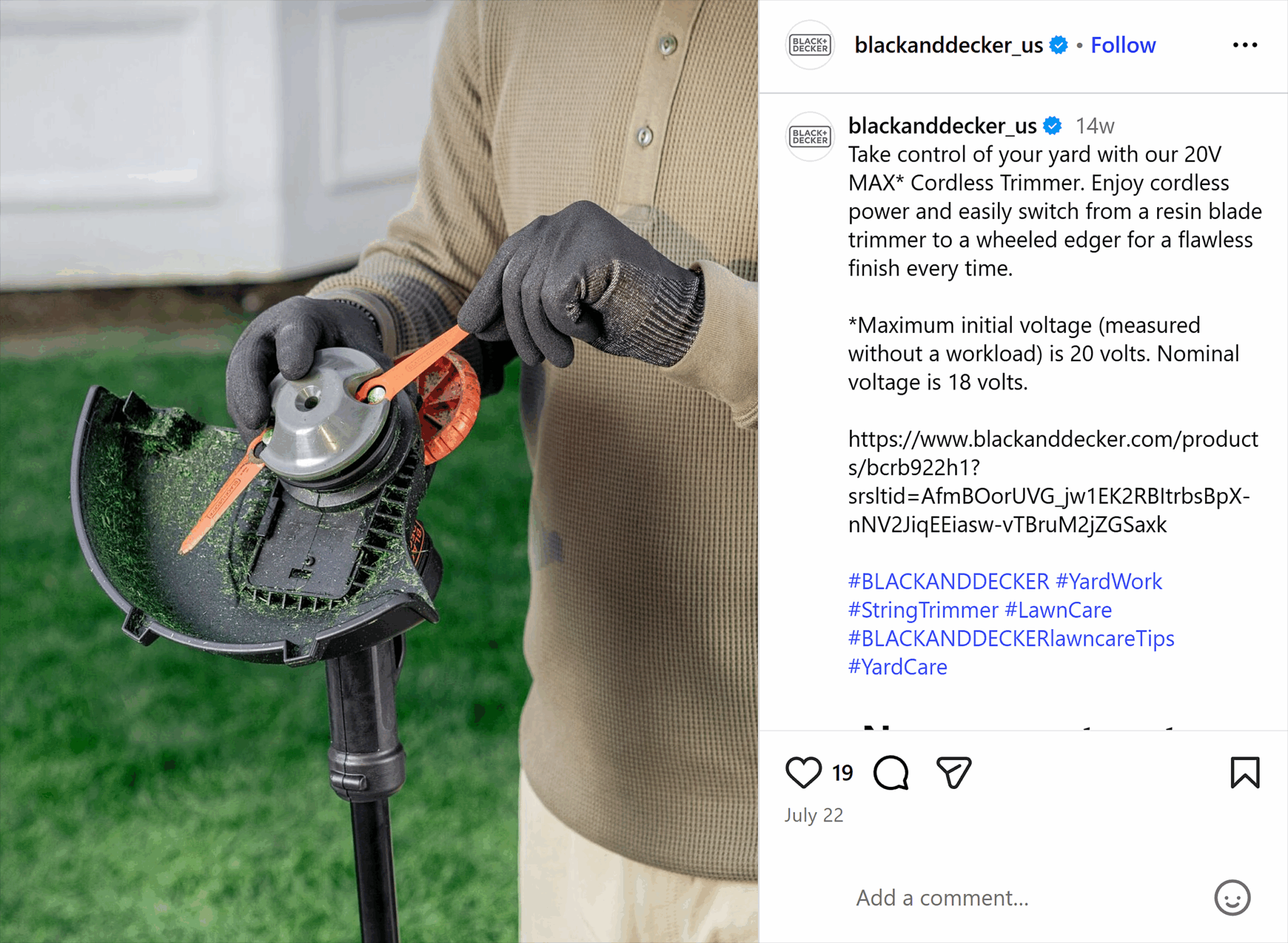
A social media post from the official Black and Decker accounts uses an image that positions the brand as applicable for smaller home projects.
Now again, imagine if the brand wanted to pivot towards industrial-level products. There would be a lot to start aligning.
Currently, if we look at how LLMs understand the brand when specifically determining if it is a relevant option at the industrial level, the outlook is problematic and demands much alignment work to be done.
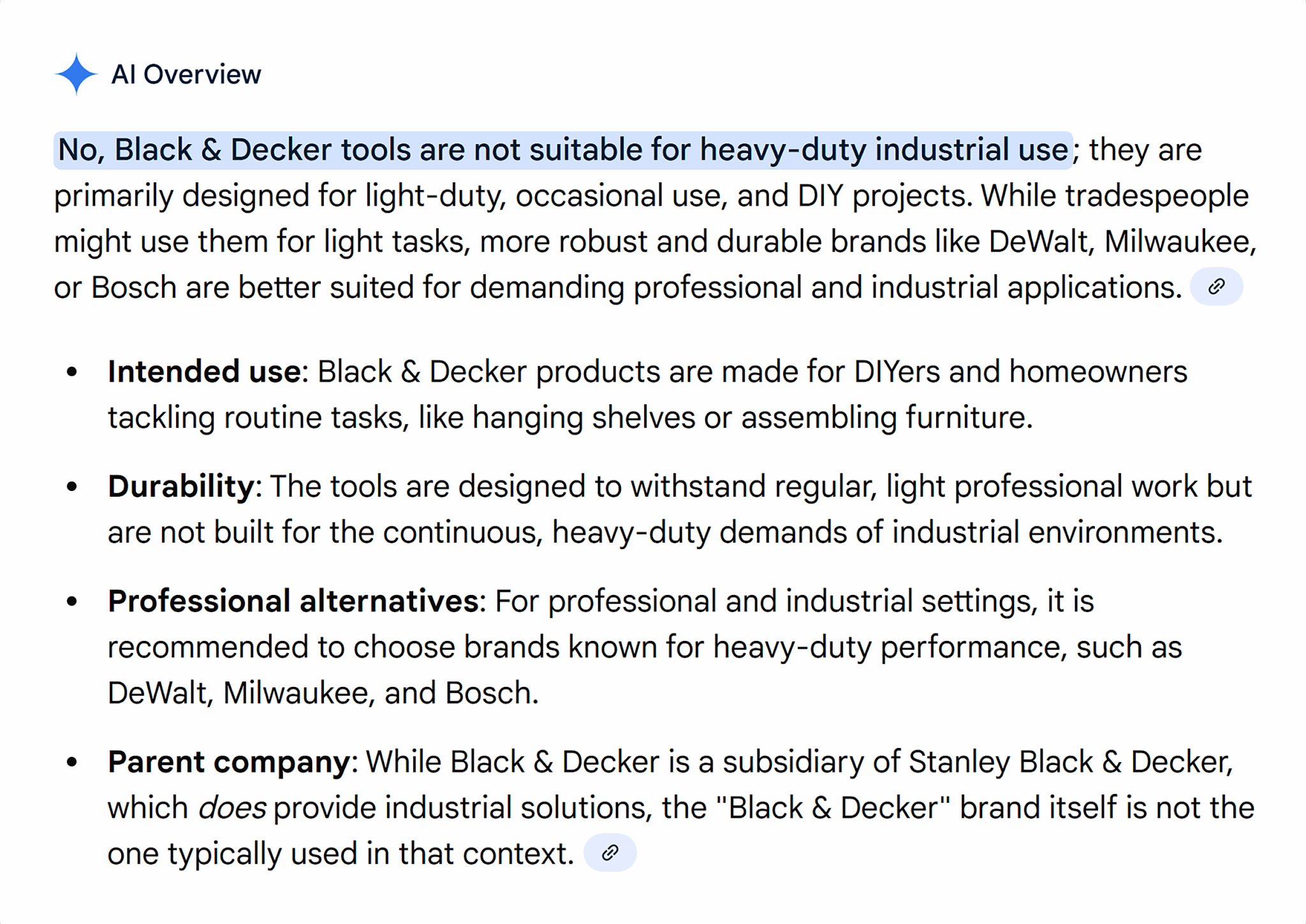
A Google AI Overview specifically says the brand is not suitable for industrial use.
Once again, the above screenshot shows the parent brand (Stanley Black and Decker) and the product’s website dominating the citations. There would be various teams to align to get LLMs to start seeing the brand differently.
After quickly reviewing the citations above, it becomes clear that the company would need to work on the content and language used both on the parent site (Stanley Black and Decker) and on the specific sub-brand site (Black and Decker).
That’s already at least two different content teams that would need to align.
However, that’s just the start.
Even internally, alignment goes way beyond just these two aspects.
Look at what Google’s AI Mode returned for the prompt “are black and decker mowers meant for anything but home use”:

For starters, there is a citation back to one of the brand’s own support pages, which states:

The company’s own support content explicitly says this product is not for commercial use. If the brand were to pivot to commercial use, it would need to align its support content. Now we’re up to a minimum of three internal content teams to align.
The issue, however, should the brand ever want to pivot, would be far broader. Look back at the AI summary. Google’s AI Mode is making a conceptual connection between durability and commercial use, such as when it says, “Black & Decker mowers often feature plastic decks and lighter-duty components…”
That conceptual connection is supported by what third-party sites are saying. Here’s what the content on MachineFinder says (see the second citation above):
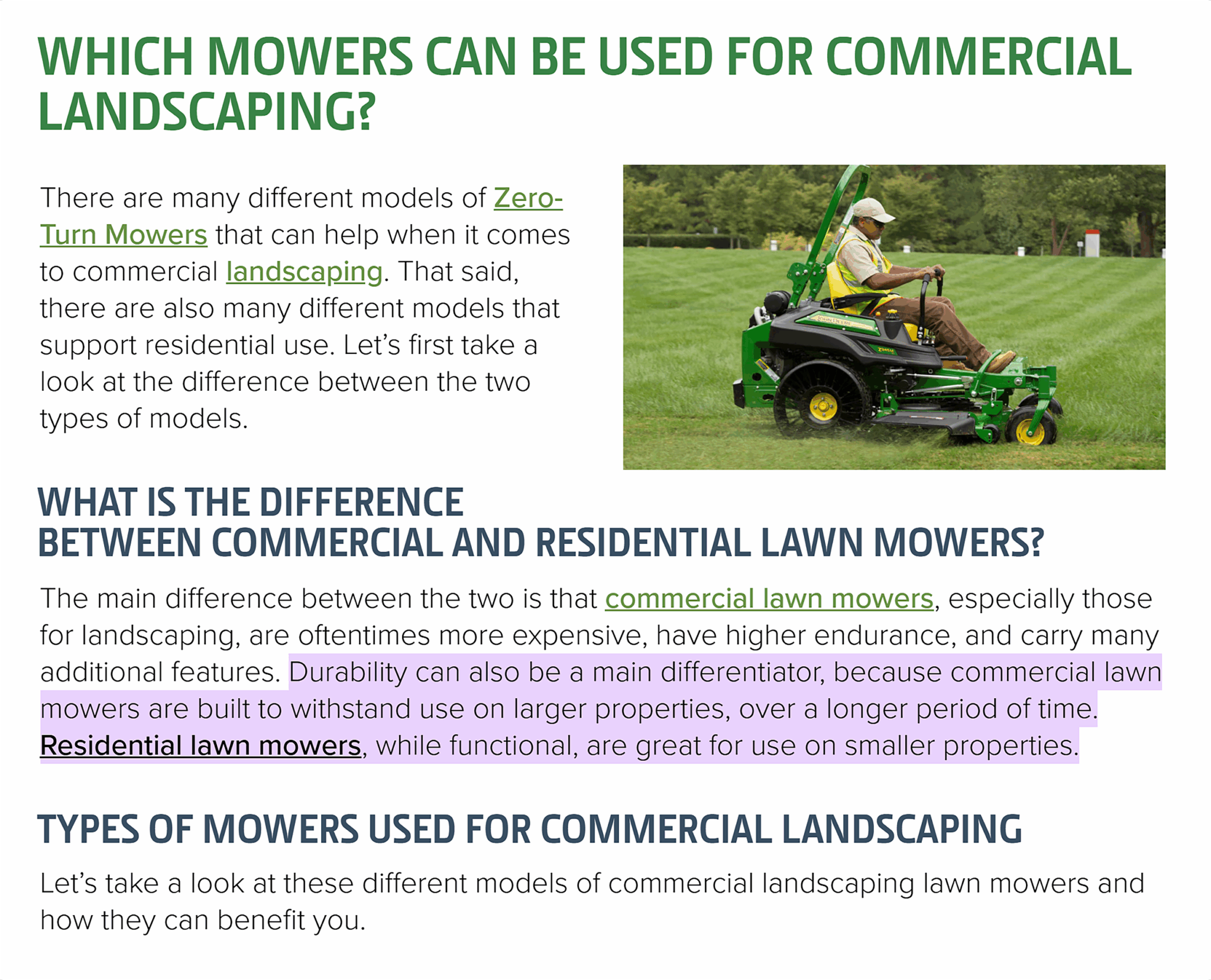
The sites that support the LLM output are saying that there is a direct connection between the material used in the product and its durability.
You might think this means the brand now has a problem in aligning what third-party content says about its product. This is 100% true. Though it’s not the full story.
The brand here would have a product problem.
If it wanted to pivot, it would need to either stop using plastic parts so as to be seen as a durable and therefore good commercial option… or it would need to change how the entire industry sees the durability of plastic parts.
The latter is most likely not possible, nor time-effective even if it were.
Now you need not only several content teams aligned, but also the product team on board. Forget them being a different “team” within marketing… Product is an entirely different part of the company!
Moreover, think about how broad a shift that would be. You’d need to update the product and then ensure that every product spec across the web focused on the change in product material.
That’s a huge undertaking.
And we haven’t even talked about how social media, forums, and other third-party content would factor into the equation. (I feel like I am already overwhelming you!)
What are you supposed to do about this?
It seems impossible.
It’s definitely an uphill battle. It will take time. It is, however, not impossible. In fact, it is fundamentally a two-step process.
Step one: Create conceptual alignment
Before you can do anything else, you must have conceptual alignment. Otherwise, anything you try to execute will be an uphill battle of trying to herd consistency like it was cattle.
How do you do that? How do you create conceptual alignment across the brand?
There’s no way around it, you have to do the one thing most companies spend the least amount of “marketing time” on: understanding who you are as a brand.
Why do I say this isn’t something that brands spend time on? It’s very simple: It’s hard to do, it’s hard to quantify, and there is no direct or immediate ROI. Instead of ensuring this fundamental of all fundamentals is in place, marketing teams often jump right into performance with the minimums of “brand.” (Essentially, minimal positioning and some messaging.)
LLMs and the quest for AI visibility is changing this dynamic, because the only way to develop alignment is to create a unified concept that cuts through every marketing action you take. And the only way to do that is to develop a strong and crystal clear sense of identity.
In my opinion, you’re looking to create a brand identity concept that is:
- Meaningful
- Clear (you can’t communicate to others what is not clear to you)
- Differentiated (if you handle the previous two bullets, this usually happens naturally, but not always)
How do you do that?
Essentially, you are trying to understand yourself (as in your own company/brand).
Often, this turns into cliches such as “What is our company culture?” or “What are our values?”
To avoid this problem, here are some questions I recommend mulling over and discussing internally:
- Outside of the income it generates, why do we think our offering is important and worth our time?
- What is our company history, and why was it created to begin with?
- What problems do we think affect the health of our industry overall?
- What mental state do we want our customers and clients to walk away in?
- What bothers us about how our competitors go about their business and their offering?
It’s not about answering these specific questions (although these are good questions, if I do say so myself), it’s about a certain line of thinking.
In a nutshell, you want to uncover what is meaningful about what you do and why you do it.
Then, take that concept and ensure it is present, at some level, in everything you do. It’s a unified concept that runs throughout all of your marketing (and well beyond). That conceptual unification is both where alignment starts and where it falls apart.
I’ll give you an example to make this more concrete.
Minivans. (I have four kids, so this example is quite applicable to my life.) Minivan companies often try to position themselves as being “sporty” or something similar. Here’s how Toyota speaks about it on their website:
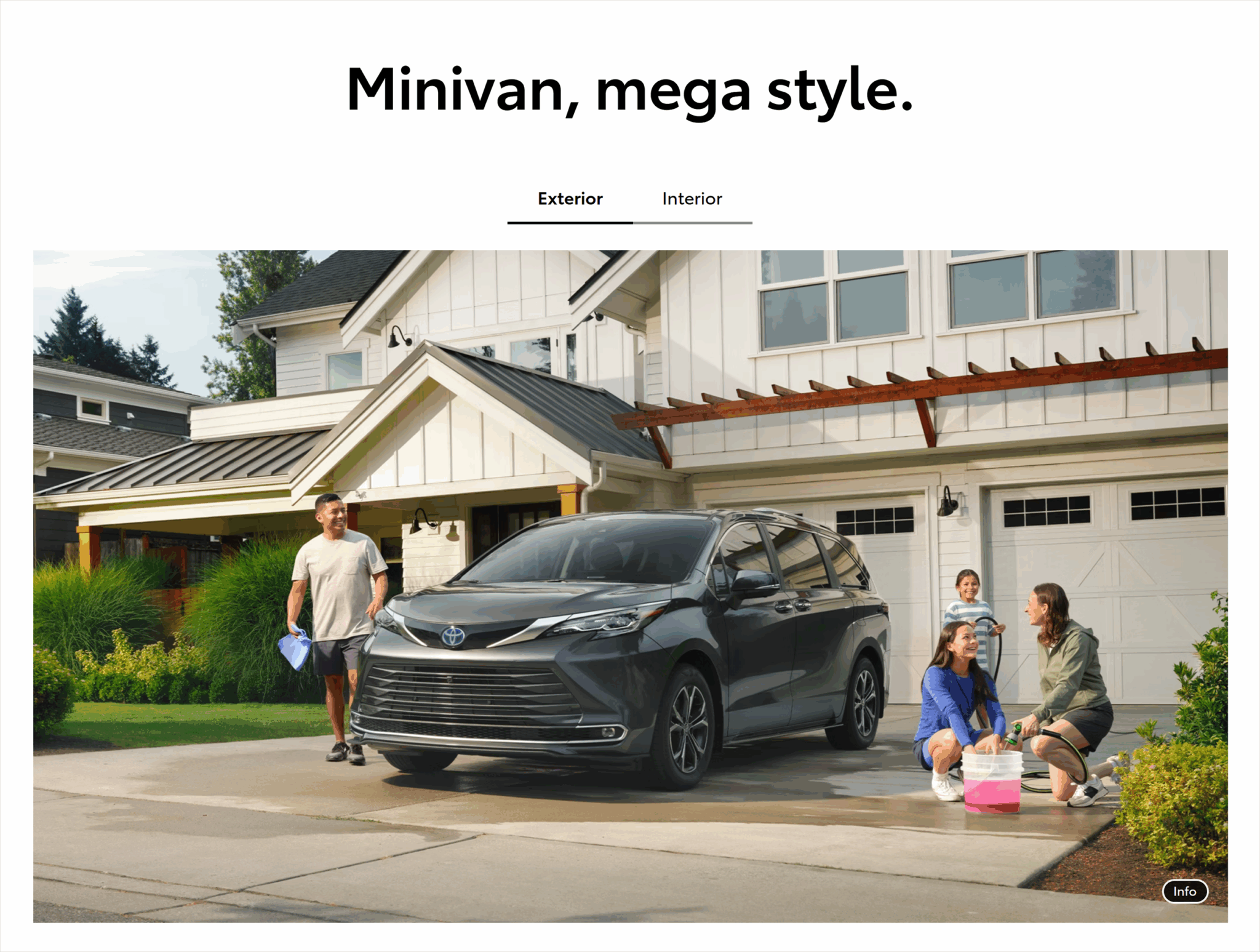
“Mega-style.”
It’s a heavy focus on “people feel self-conscious” about driving a minivan. I personally think that is an overgeneralization and that most people “own up” to the minivan stage of life.
What if we took this from a different perspective? What are we all about as a minivan company?
I want to take some of the questions I proposed above and answer some of them as if I were the marketing team at Toyota or Honda. For the sake of time, I’m just going to answer the last two:
- What mental state do we want our customers and clients to walk away in?
Answer: To feel the level of detail we offer in our design. We want our customers to see and appreciate how much detail we considered. How we tried to preempt all of the needs and uses they would have with the nuance in the design we engineered.
- What bothers us about how our competitors go about their business and their offering?
Answer: We feel that companies trying to position a minivan as what it’s not is disingenuous. A minivan isn’t a sports car. It’s not a fashion statement. It’s a part of your family experience. It’s a part of your family dynamic more than anything else, and our goal is to make that dynamic as healthy, easy, and wholesome as possible (which, when you’re hauling kids from errand to errand, is easier said than done).
Who are you? If this is how our fictitious minivan producer answered these questions… Who are they?
Based on how they answered the above, what is the unifying concept they can thread together?
To answer this question, we have to pull out the themes in the responses. As a point of methodology, always try to think thematically when working on brand and alignment.
For our purposes, I am going to pick two themes (methodologically, you have to weed out which themes to focus on and which to put to the side).
Themes:
- We care about every detail. We are about crafting and engineering a profound level of quality and detail into what we do.
- We care less about the surface-level considerations and more about the deeper dynamics our consumers face.
How do we put those two together? What’s the one concept?
We craft our product with a unique level of detail so the consumer’s experience can be more genuinely meaningful.
Everything this brand does should communicate the absolutely incredible level of attention to detail they have. Everything this brand does should showcase their dedication to detail and why that matters so much.
It literally walks right into brand positioning (which would focus on what the family dynamics are and how attention to detail in the vehicle’s engineering helps that dynamic).
This is how positioning a brand should work. The positioning should ooze out of the brand identity, making it clear and obvious.
This is your rock. This identity concept is what keeps you aligned. It keeps you focused. It creates the consistency in everything that an LLM is looking for.
If we were our imaginary minivan company, should we create a landing page that emphasizes our van’s sporty look? No.
Should we target keywords about sport design and minivans? No.
Should we talk a lot about how much horsepower the engine has on social media? No.
Should our booth at the auto convention showcase the edgy new design we have planned for next year? No.
Should we talk about how much emphasis on the details we put into the design so that the consumer’s experience is more rewarding? Yes.
Should we run a social campaign about how much you deserve a minivan that appreciates you and your family with a level of detail and design that isn’t otherwise available on the market? Yes.
Do you see where I’m going with this?
If you don’t know who you are as a brand and what your core brand concept is, it will be 100% impossible for you to be aligned and consistent. This will make your LLM visibility far more complex and challenging than you would like it to be.
There’s still one more outstanding question. How do I get all of the various teams on board and in sync with the core identity concept our company has developed?
Because even if you have the most outstanding core identity concept, it won’t help your LLM consistency if the different teams across the company aren’t aligned with it.
Discover how you appear across LLMs like ChatGPT, Perplexity, and Google AI, and get AI-powered strategy recommendations.

Step two: Create organizational alignment
What we are fundamentally left with is an operations question. Which, as a former COO, I appreciate very much.
The ops problem is easy to see. You have disparate teams spread across a company that often have nothing to do with each other, impacting each other in a unique way, all thanks to LLMs.
Personally, this is a good problem, and one companies have avoided for years but are now forced to tackle (and that’s just the way it goes).
My advice?
Create a task force.
Create a task force and appoint ONE person to lead it, with the goal of improving brand visibility and consistency inside of LLMs.
I wouldn’t try to take a current team and put them in charge. That feels like putting a square peg into a round hole. It’s like when you start a project around the house to fix something up and then realize four days in that it’s easier just to tear it all down and start again.
Don’t waste time trying to fit a current team into a new context only to realize you have to tear it down and start from scratch. Just start from scratch.
The first thing the person running the “LLM task force” should do is form a fraternity.
When I worked at Wix, we called them “guilds.” Call it a guild, call it a fraternity, a fellowship, a federation, whatever.
Whatever you call it, it is a cross-vertical association of all of the people who touch on and impact how you appear in LLMs.
Anyone and everyone (or a representative of them) is a part of this “federation.” (Sorry, I am a Star Trek fan.)
Social, knowledge base, UX, product(s), creative, SEO, paid marketing, owned media, PR… every one of these teams should have a representative in this “LLM visibility and consistency federation.”
This “federation” is where you are going to sync and communicate the core brand concept so that there is widespread adoption across the company. It’s where every facet of the company that impacts how and when you appear in LLMs comes together and takes back that core concept to their respective teams.
This is where the alignment actually happens.
And I want to say, this isn’t some sort of “monthly sync” that half of the people don’t show up to. (I see you.) This is something that should come down from leadership, that should be both regular and quantifiable (i.e., there has to be accountability).
To the latter, I recommend you create some sort of audit that ties into LLM visibility and consistency data. Divide that audit into categories based on each of the teams that comprise your “federation.” Each team gets an audit report that grades them on their alignment and offers concrete changes that should be implemented. For this, you will 100% need buy-in from leadership (or else the teams will simply ignore the audits and their recommendations).
External alignment (as in aligning how LLMs perceive your brand) starts with internal alignment.
Alignment sounds complex, but it is doable
You got this.
Developing the brand alignment you need to create consistency and desirability of messaging within LLMs is very difficult. It’s difficult because it’s a concept we keep hearing about, but it’s vague at the same time.
It’s difficult because not only is the notion vague, but even when there is clarity (which I hope I’ve brought some here), it’s very layered. There are so many foundational things that need to be addressed in order for alignment to happen. To me, that’s what makes it so hard. There is so much to be constructed and developed that initially resides beneath the surface.
The good news is that once you are able to tackle what lies beneath, alignment is very doable. It’s not something that is out of reach. Which means consistency and alignment within the LLMs themselves is not out of reach. It’s just a new paradigm to consistently adapt to.







Recent Comments